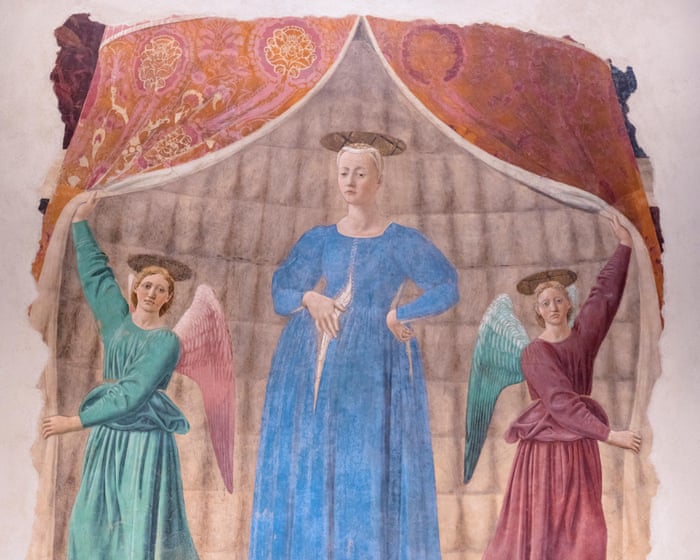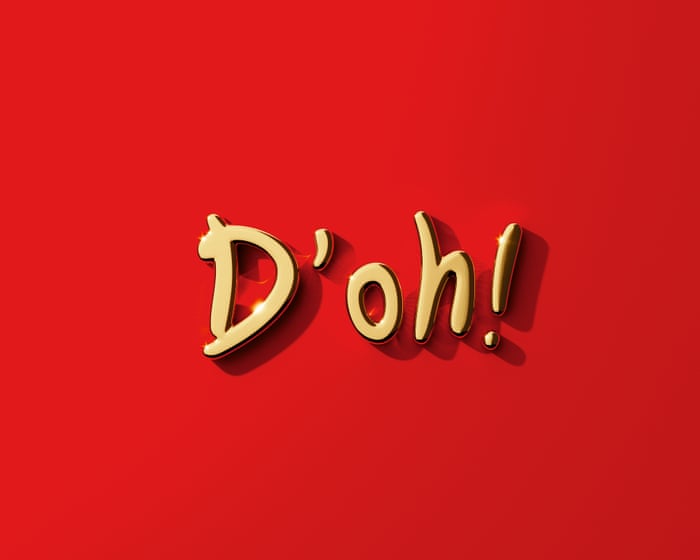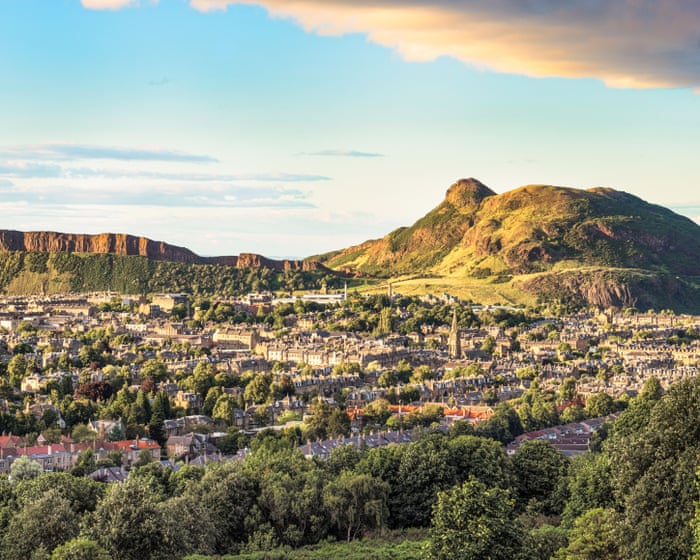Der er et maleri, jeg ofte tænker på—**Madonna del Parto**, et mesterværk fra 1460 af Piero della Francesca, der er udstillet på et lille museum i Monterchi i Toscana. Det viser Jomfru Maria, højgravid, med to engle ved hendes side. I generationer har lokale kvinder æret det som en beskytter af frugtbarhed og fødsel. Under 2. verdenskrig konfronterede de endda mænd, de troede var nazister, der forsøgte at stjæle det. Senere, i 1954, protesterede de mod planer om at flytte det til Firenze ved at lægge sig på gaden for at forhindre dets fjernelse.
Jeg mindedes disse kvinder i går, da jeg gik gennem Jenny Savilles udstilling på National Portrait Gallery og så, hvordan renæssancekunsten har formet hendes værker. Savilles fascination af de gamle mestre begyndte i hendes barndom, takket være en kunsthistoriker-onkel, der tog hende med til Venedig. Den påvirkning er tydeligst i hendes moderskabsmalerier—rå, kraftfulde billeder af hende med sine børn, der giver genklang af Leonardo og Michelangelos værker. Du kan næsten se deres madonnaer i de hvirvlende skitser omkring hendes figurer. Et af hendes mest slående værker, **Pietà I**, en studie i kul og pastel, opstod fra hendes dybe engagement med Michelangelos **The Deposition**.
Jeg er bange for, at jeg mister dig i kunsthistorisk snak, så lad os vende tilbage til de protesterende kvinder i Monterchi. I mine tidlige tyvere kunne jeg ikke fatte at bryde sig så meget om et renæssancemaleri, at man ville lægge sig på gaden for det. Dengang lod religiøs kunst mig kold—sandsynligvis fordi jeg ikke blev opdraget med tro. For mig var det alt sammen stive baby-Jesuser og folk, der knælede i ærefrygt. Jeg forstod dens historiske betydning—fødslen af perspektivet!—og studerede pligtskyldigt Titian og Michelangelo, bestod endda en mundtlig eksamen om Leonardos værker. Men hvis jeg havde valget, foretrak jeg altid abstrakt og samtidskunst. En Rothko eller Joan Mitchell talte til mig på måder, renæssancemalerier aldrig gjorde.
Jeg vidste, problemet var mig—jeg forstod det bare ikke. Den mystiske gnist, som nogle kunstværker har, den måde det resonerer på, undgik mig. År senere, da jeg stod i Savilles udstilling, omgivet af hendes mor-og-barn-værker, indså jeg, at min afstand ikke kun handlede om religion—det handlede om livserfaring. Som 23-årig, efter at have overlevet et drabsforsøg, skiftede min smag mod det barokke (prætentiøst, måske, men trauma former os, ofte gennem kunst—tænk på dette som min dødsmetal-fase). Jeg slæbte min daværende kæreste gennem Roms kirker for at se Caravaggios; jeg stod foran Artemisia Gentileschis **Judith Slaying Holofernes** på Uffizi og mærkede hendes vrede.
Jeg græd ikke ved Savilles udstilling, men jeg var tæt på foran **Aleppo**, hendes **Pietà** for Syriens børn.
Da jeg var yngre, føltes oprigtighed uudholdeligt sårbar, så som mange i deres tyvere gemte jeg min naivitet bag en kynisk distance. Men livet sker—nogle gange forfærdelige ting—og at blive ældre gør det lettere at bryde sig dybt uden at skamme sig. Dengang undgik jeg den følelsesmæssige vægt af visse oplevelser—ikke kun død, men alt, der havde med moderskab at gøre. Jeg ville ikke derhen.
Så, omkring den tid, jeg begyndte at tænke på at få et barn, følte jeg mig draget af malerier af Bebudelsen—det øjeblik, hvor englen Gabriel fortæller Maria, at hun skal føde et barn. Hvis man ser bort fra troen på jomfrufødslen, begyndte kunsten selv at bevæge mig på måder, jeg ikke havde forventet. Tanken om at fange den følelse—det øjeblik, hvor man indser, at livet er ved at ændre sig fuldstændigt—fascinerede mig pludselig. Det blev endnu mere overbevisende, da jeg fandt ud af, at jeg var gravid.
Som barn havde jeg kopieret englen fra Fra Angelicos **Bebudelsen** fra en af min mors bøger, fuldstændigt uden at bemærke Maria. Men år senere, da jeg stod foran maleriet i Firenze som voksen, var det kun udtrykket i hendes ansigt, jeg kunne se. At se kunst i virkeligheden gør en forskel, men jeg mistænker, at hormoner også gør.
Denne sommer opdagede en nær veninde, at hun var gravid—så hurtigt, at hun var lige så chokeret, som jeg havde været. Jeg sendte hende et billede af det maleri og spøgte, at Maria "ser ud som om, hun er ved at kaste op." Måske har jeg stadig en vej at gå i at slippe min modstand mod oprigtighed, men jeg ville ikke bytte min nuværende selv med min yngre, mere kyniske version. Jeg vil hellere være den person, der lige havde født og græd foran en Rafael-madonna—uanset hvor pinligt det var.
Jeg græd ikke ved Jenny Savilles udstilling, men jeg var tæt på foran **Aleppo**, hendes Pietà for Syriens børn. Maleriet syntes at rumme al den sorg og pine hos mødre i Gaza, der har mistet børn til Israels vold. Det fik mig til at indse, at kvinderne i Monterchi ikke kun beskyttede et mesterværk—de beskyttede hinanden og deres børn, som de så det.
At tillade sig at blive rørt af kunst betyder også at åbne sig for andres smerte—endda at være villig til at løbe risici for dem. At lægge sig på gaden, med andre ord.
Rhiannon Lucy Cosslett er en Guardian-kolumnist. Hendes roman **Female, Nude**, om kunst, kroppen og kvindelig seksualitet, udgives i 2026.
OFTR
### **Ofte stillede spørgsmål om "Jeg troede aldrig, renæssancekunst betød noget for mig. Så ændrede livet sig—og jeg forstod dens sande kraft."**
#### **Begynderspørgsmål**
**1. Hvad er hovedpointen i Rhiannon Lucy Cossletts artikel?**
Artiklen undersøger, hvordan renæssancekunst, som oprindeligt virkede irrelevant, blev dybt meningsfuld for forfatteren under en personlig krise, og afslører dens følelsesmæssige og psykologiske kraft.
**2. Hvorfor brød forfatteren sig ikke om renæssancekunst før?**
Hun så den som fjern, gammel og adskilt fra det moderne liv—indtil personlige udfordringer fik hende til at se dens tidløse temaer om lidelse, skønhed og modstandskraft.
**3. Hvordan hjalp renæssancekunsten forfatteren?**
Den gav trøst, perspektiv og en følelse af forbindelse til menneskelige erfaringer gennem tiden, hvilket hjalp hende med at håndtere svære følelser.
**4. Hvad er et eksempel på renæssancekunst nævnt i artiklen?**
Forfatteren nævner værker som Michelangelos *Pietà*, der viser Maria, der holder den døde Kristus, som symbol på sorg og medfølelse.
**5. Skal man være kunstekspert for at sætte pris på renæssancekunst?**
Nej—forfatteren viser, at personlig forbindelse betyder mere end teknisk viden.
#### **Mellemniveau-spørgsmål**
**6. Hvordan relaterer renæssancekunst sig til moderne udfordringer?**
Den omhandler universelle temaer—kærlighed, tab, tro, lidelse—hvilket gør den relevant selv i dag.
**7. Kan kunst virkelig hjælpe med følelsesmæssig heling?**
Ja, som forfatteren oplevede, kan kunst give trøst, refleksion og en måde at bearbejde følelser på.
**8. Hvad adskiller renæssancekunst fra andre stilarter?**
Den lægger vægt på realisme, menneskelig følelse og religiøs/mytologisk fortælling, ofte med dyb symbolsk betydning.
**9. Hvordan kan man begynde at sætte pris på renæssancekunst, hvis den virker kedelig eller forældet?**
Søg efter værker, der resonerer med dine egne erfaringer, læs deres historier, eller besøg et museum.
**10. Ændrede forfatterens syn på kunst sig permanent?**
Ja—hun ser den nu som en kilde til styrke og forbindelse snarere end blot historiske artefakter.
#### **Avancerede spørgsmål**
**11. Hvordan forbinder artiklen renæssancekunst med mental sundhed?**
Den antyder, at engagement med kunst kan være terapeutisk og give en måde at bearbejde smerte og finde mening på.




